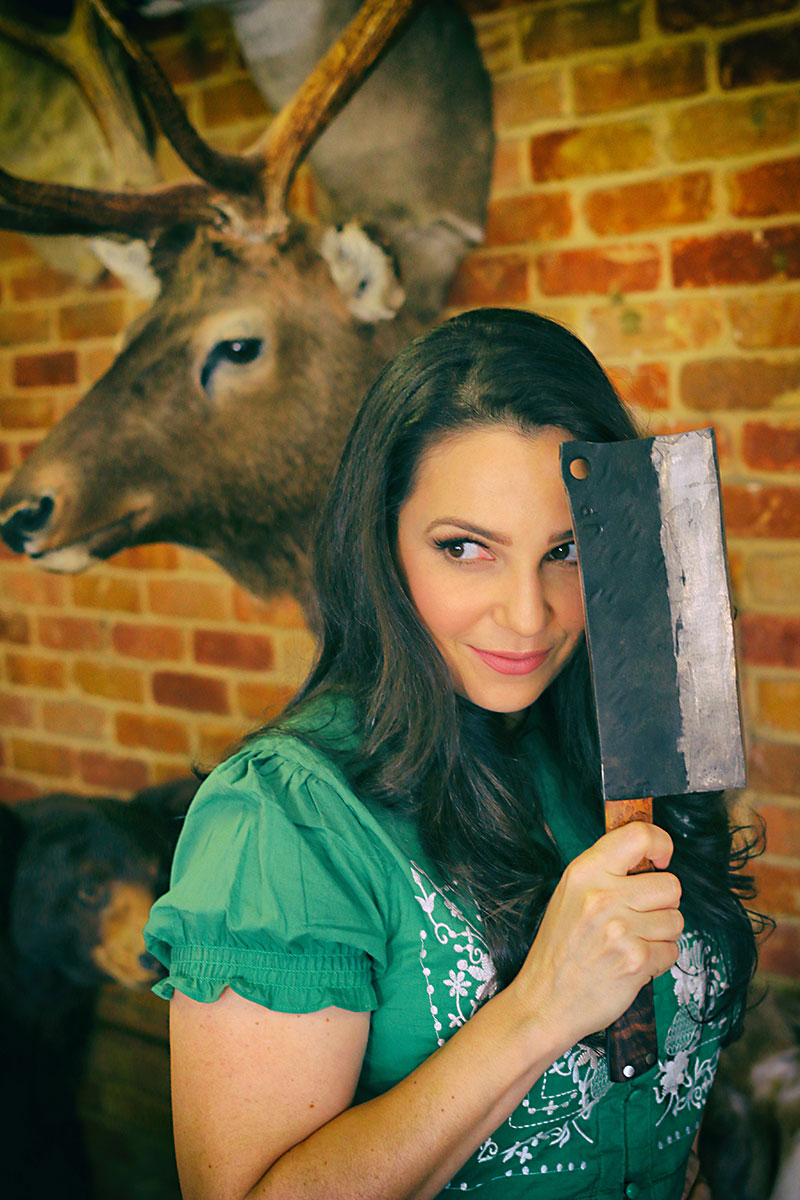How to Cook Meat and Influence People
Jess Pryles and the making of an Austin food celebrity
By Dan Gentile, Fri., Feb. 24, 2017
At 9am on a chilly February Saturday, 40 amateur meat enthusiasts gather at the Texas Beef Council for a workshop led by self-proclaimed "hardcore carnivore" Jess Pryles. The crowd has traveled from as far as Vermont, ranging from ranchers to backyard cooks to veteran pitmasters. It skews heavily male, with an impressive percentage sporting Yeti drinkware. It's the first time Pryles has hosted a workshop, but it doesn't show. By the end of the four-hour session, they'll know enough beef facts to impress the hell out of their friends and will likely never buy an overpriced tenderloin ever again.
Jess Pryles first visited Austin from her home in Melbourne in 2009, and at times a heavy Australian accent still pokes out. Her odyssey into the professional food world began with a beef rib from the now-defunct Artz Rib House on South Lamar.
"We didn't have smoked meats like that in Australia. That barky, peppery, beefy extremeness. I always loved when Mom would make lamb chops, gnawing at the little crispy bits at the end that were rendered and delicious. This was like a whole rib of that," says Pryles.
That aha bite of beef led her to build a website devoted to an unapologetic love of all things meaty. She still lived in Australia, but kept returning to Austin in order to stay abreast of the Central Texas brisket boom. Then in 2015, she took the plunge and became a U.S. citizen and resident Austinite in order to commit herself fully to studying and advocating the consumption of smoked proteins. Fast-forward two years and she's designed a signature model of offset smoker, is regularly booked for TV appearances, signed a book deal, and sells an internationally distributed line of steak rubs.
It's a Cinderella story that most people would love to emulate, turning a passion for food into a career. It might seem like easy money – dream up recipes for al pastor wontons and watch the product endorsement money roll on in. Haters might decry that anyone can do it, that food personalities like Pryles have just weaseled their way into monetizing the same barbecue pics that every person in line at Franklin Barbecue would take. And she's the first to admit that there are shortcuts.
"There's two approaches; one is to take the quick and easy route. Play the SEO game, do whatever you can to grow Instagram followers, be it reposting or using bots. The other is to look at it like a long-term brand project," says Pryles.
Pryles has taken the long route, which means studying under industry heavyweights and building a legit website full of practical and polished content. Stories like a first-timer's guide to hunting, bacon curing tips, or a day in the life of the pitmaster at Stiles Switch. Some posts are sponsored, like a Meat Lover's Guide to Uvalde County, but there aren't any ads or linkshares cluttering up the page. It has the look and feel of a trusted resource, not a generic Wordpress skin. One of her biggest suggestions for anyone looking to enter the world of food media is to invest in a professional site.
When it comes to social media, Instagram is key. Pryles boasts 46k followers, a respectable number, but it's not a blockbuster following. Thankfully these days when brands consider investing in content creators, it's not necessarily the size of the audience, but engagement. A photo of the 60-day dry-aged hunk of beef used in her workshop scored over 2,200 likes. Pryles politely declined to talk numbers, but another local Instagrammer explained that an industry formula for sponsorship is to average the number of likes on your past 10 posts, then multiple that by a base rate (often $1). The numbers obviously differ based on campaigns, and it's a stretch to say one rib eye photo is paying Pryles' mortgage for the month, but the figures are enough to make me realize I should probably start using more hashtags.
Thankfully for the attendees of the workshop, Pryles does more than just gaming Instagram all day. Anyone can pick the perfect filter for a beef rib, but you can't hire an Instagram bot to saw into a subprimal in front of 40 men, remove the top blade roast, and fillet two flat iron steaks (cuts nearly as succulent as the tenderloin, but at a fourth of the cost). It's this type of expert authenticity that has drawn attention from legit industry partners like the Texas Beef Council.
"We know that it's a little bit hard to choose different beef cuts at the store," says Rachel Chou, senior communications manager at the TBC. "How to cook them and season them is a complicated process, so we want to work with people that can break down those barriers."
As promised, the workshop does just that. I'd personally consider myself an informed carnivore, but the four-hour session proved otherwise. Beforehand, if you'd asked me at what age cattle live to before becoming beef, I wouldn't have even had a guess. Turns out it only takes between 18-24 months to grow calves to an industry standard of approximately 1,150 pounds, 62% of which is usable meat. That growing period means that the industry requires about three years to adjust to any dramatic changes in demand, like when Arby's announced a brisket sandwich in 2013 and threw barbecue margins into a tailspin.
Granted a curious Google could solve this type of mystery, the real strengths of the workshop are the hands-on elements. Explaining the meaning of the terms on meat packaging in the grocery store is one thing, but without a side-by-side taste test, it's hard to see past the marketing.
"Every single steer in the U.S. is grass-fed," says Pryles. "When you see grass-fed, that means as much as Black Angus," which is the most common breed in the U.S.
But grass-finished is another story. A blind tasting left the attendees split in preference between the grain- and grass-finished, with some preferring the roasty and fattier taste of grain, others gravitating toward the buttery and earthy taste of grass. The crowd was more united when it came to USDA quality, with a near-unanimous preference for prime over select and choice. The samples were tasted unsalted, which exposed soapy and musty flavors in the lower quality cuts. Pryles also shared the grading rubrics used by USDA inspectors and displayed uncooked fillets that showed clear differences in marbling.
The workshop concluded with some old-fashioned grilling. Attendees mixed a bottle of their own rub from a table of 15 spices, then used it to season flat iron steaks. Or if you preferred, everyone's gift bag included a bottle of Pryles' signature Hardcore Carnivore rub, which features activated charcoal to give even pan-seared meat a gritty bark. I didn't see anyone reach for the Hardcore Carnivore at their grill stations, but folks didn't fly from as far as Vermont to emulate Pryles. They came to be inspired by her and take their own cooking to the next level. It's hard to say whether anyone other than their friends and family will take note, but if nothing else, they'll score a few extra likes.









